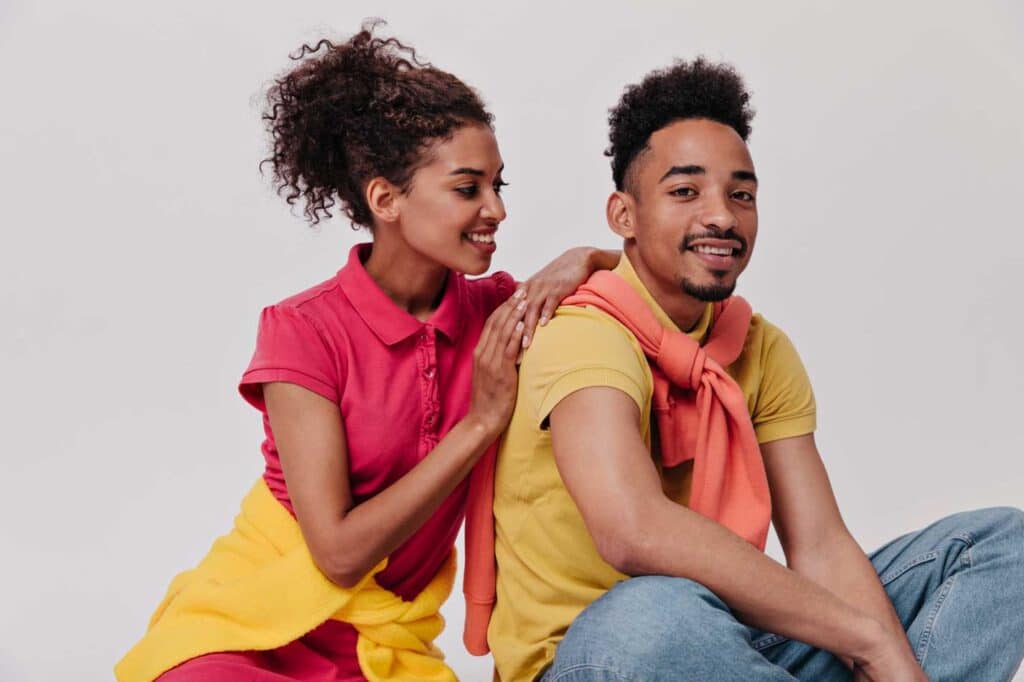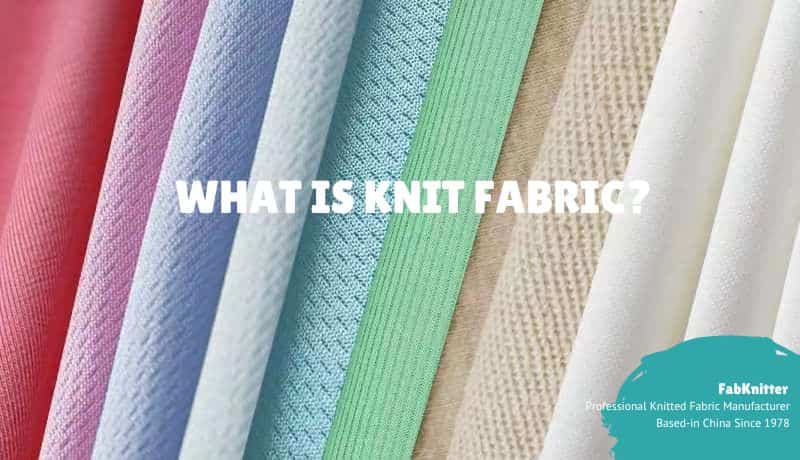If you’ve ever wondered what makes your favorite cozy sweater or stretchy t-shirt so comfortable, it’s time to dive into the world of knit fabric. In this article, we’ll unravel the secrets of knit fabric, explaining what sets it apart from woven fabrics and why it’s the go-to choice for comfy and stylish clothing.
If you’re ready to elevate your fabric knowledge and make smarter clothing decisions, keep reading!

Understanding Knit Fabric
Knit fabric stands as one of the two primary categories; woven fabric is the other primary category. However, knit fabric offers unique characteristics that make it a favorite for many clothing applications. Here’s what to know about knit fabric:
Woven vs Knit Fabric
Knit fabric is crafted through the intricate art of knitting. This process is weaving yarn together in rows, creating a fabric that is different from woven cloth. Woven fabrics are interlacing threads over and under each other.
On the other hand, knitting produces a fabric that’s more elastic and pliable. This elasticity is what makes knitted garments more comfortable and versatile.
Hand-Knitting vs Machine Knitting
Knitting is often more known as an age-old craft of creating garments such as sweaters, stockings, and hats by hand. While the fundamental principles are similar, modern knit fabrics are primarily produced using machines.
Hand-knitting is labor-intensive, on the other hand knitting machines are faster for mass production.
Knitted fabrics can be created from a wide range of yarns, but for industrial applications, single filaments are commonly used. These single wires or polymeric filaments constitute the majority of knit fabric materials.
How Knitting Works
Knit fabrics are formed by capturing each row of loops into the row before it, creating an interlocking pattern of loops. This interlocking structure is made from one or more yarns.
The first frame knitting machines marked a significant milestone in the development of knitting technology. It enabled the production of entire rows of loops simultaneously.
2 Styles of Knitting
Weft Knitting
Also known to be circular knit / tubular knit, weft knitting involves creating fabrics where loops are formed horizontally from a single yarn, with each subsequent row of loops building upon the previous rows. This style results in warm, cozy, and highly elastic fabrics.
Warp Knitting
Warp knitting, on the other hand, produces loops from each warp yarn vertically along the length of the fabric. This style results in smoother knitted stitches with a diagonal criss-cross pattern and less flexibility compared to weft knitting.
Types of Knit Fabrics
Knit fabrics come in a vast array of styles, each with its own unique characteristics and applications. Here’s a glimpse into some of the most popular knit fabric categories:
Jersey Knit

This fabric features a smooth, flat surface on one side and a textured, interlocking pattern of loops on the other. It’s highly stretchable, making it comfortable for everyday wear.
Jersey knit is one of the most recognizable types of knit fabrics.
- Applications: Commonly used for t-shirts, casual dresses, and sportswear.
Rib Knit

Rib knit is known for its distinct vertical ridges or “ribs” that run along the fabric’s length.
This fabric’s elasticity allows it to conform to the body, making it an excellent choice for snug-fitting garments.
- Applications: Often used for cuffs, collars, and waistbands in clothing.
Interlock Knit

Interlock knit is a double-knit fabric that’s incredibly soft and thick. This fabric has a smooth texture on both sides, making it reversible and ideal for applications where comfort and warmth are paramount.
- Applications: Often used for baby clothing, blankets, and thermal wear.
French Terry

French terry is characterized by its looped, unbrushed back and smooth face.
With its moisture-wicking properties and comfort, French terry is a go-to choice for activewear and cozy apparel.
- Applications: Used for sweatshirts, hoodies, and loungewear.
Jacquard Knit

Jacquard knit fabrics are created using intricate, multi-colored patterns and designs. The Jacquard technique allows for elaborate patterns and images to be woven directly into the fabric, making it a canvas for artistic expression in fashion.
- Applications: Used for creating eye-catching knitwear.
Velour

Velour is a knit fabric with a plush, velvety surface that’s incredibly soft to the touch.
This fabric’s luxurious feel and sheen make it a preferred choice for creating elegant, comfortable attire.
- Applications: Used for tracksuits, loungewear, and evening wear.
Mesh Knit

Mesh knit fabrics are lightweight and breathable, featuring an open, net-like structure.
The breathable nature of mesh knit makes it perfect for applications where ventilation and moisture-wicking are essential.
- Applications: Sportswear, activewear, and summer clothing.
Sweater Knit
Sweater knit fabrics encompass various textures, from cable knits to fine-gauge options. These fabrics offer warmth and versatility, making them a staple in cold-weather wardrobes.
- Applications: For cozy sweaters, cardigans, and winter wear.
Pique Knit

Pique knit is recognized by its waffle-like texture.It provides a balance of comfort and breathability.
The distinctive texture of pique knit adds a touch of sophistication to casual clothing.
- Applications: For polo shirts and athletic wear.
Raschel Knit
Raschel knit fabrics are characterized by their complex, lace-like patterns.
These fabrics offer a touch of elegance and femininity, making them suitable for special occasions.
- Applications: Frequently used for lingerie, evening gowns, and delicate apparel.
Knit Fabric Applications
Knit fabrics aren’t limited to just one type of garment or product. Their versatility extends to a wide range of applications, catering to both fashion and functional needs. Let’s explore how knit fabrics find their way into various aspects of our lives:
Fashion Apparel

Knit fabrics play a pivotal role in the fashion industry, gracing runways and everyday wardrobes alike. From casual wear to haute couture, they are the foundation of countless garments.
Athletic and Activewear

The stretchability, moisture-wicking properties, and breathability of knit fabrics make them ideal for sports and active pursuits. Think yoga pants, sports bras, and performance tees.
Intimate Apparel

Knit fabrics offer comfort and flexibility, making them a natural choice for lingerie and undergarments. They provide a second-skin feel while offering support.
Home Textiles

Your home is adorned with knit fabrics in the form of blankets, throws, cushions, and curtains. Their softness and warmth make them perfect for cozying up your living spaces.
Baby Clothing and Accessories

Knit fabrics are gentle on delicate baby skin, making them the preferred choice for onesies, blankets, and tiny mittens.
Sports Equipment
Beyond clothing, knit fabrics are used in sports equipment like gloves, headbands, and shin guards. Their flexibility and durability enhance performance.
Medical and Orthopedic Products
Knit fabrics find applications in medical compression garments, braces, and bandages, where support and flexibility are essential.
Automotive Interiors
Even your car interiors benefit from the comfort and durability of knit fabrics. Seats and upholstery often feature knit fabric covers.
Outdoor and Recreational Gear
Knit fabrics are chosen for outdoor gear like backpacks, tents, and sleeping bags due to their lightweight yet resilient nature.
Industrial and Technical Textiles
In industrial settings, knit fabrics serve as filter materials, protective clothing, and reinforcement fabrics for composite materials.
Knit Fabrics Care and Maintenance
It’s essential to understand how to care for and maintain these textiles to ensure their longevity and continued comfort. Here are practical tips for keeping your knit garments and products in pristine condition.
- When washing knit fabrics, opt for the gentle cycle on your washing machine. Use cold or lukewarm water to prevent excessive stretching or shrinking.
- Turn your knit garments inside out before washing to protect their surface from abrasion.
- Detergent Selection: Choose a mild, liquid detergent specifically designed for delicate fabrics. Harsh detergents can damage the fibers of knit fabrics.
- Avoid using bleach, as it can weaken the fabric’s structure and cause discoloration.
- Drying Knits: Air drying is the gentlest method for drying knit fabrics. Lay your garments flat on a clean, dry towel, reshape them, and let them air dry.
- If you prefer using a dryer, select the lowest heat setting to minimize the risk of shrinkage.
- Storage Techniques: Store knit items by folding them neatly rather than hanging, as hanging can lead to stretching.
- To prevent snagging, avoid storing knit garments with sharp or abrasive objects.
- Knit fabrics may develop pills over time. Use a fabric shaver or lint roller to remove them gently.
- Washing your knits inside out can also reduce pilling.
- Repairs and Alterations: Address any loose threads or small snags promptly to prevent further damage.
- If you’re altering a knit garment, use a stretch needle and consider using a walking foot on your sewing machine to maintain fabric integrity.
- Steam and Wrinkle Removal: Knit fabrics can sometimes develop wrinkles. Use a handheld steamer or a garment steamer to remove wrinkles gently.
- Avoid using excessive heat or pressure when ironing, as this can damage the fabric.
- Remember that different knit fabrics may have unique care requirements, so always check the care label on your garment or product for specific instructions.
Sustainable Knit Fabrics
It’s also essential to consider the sustainability of the fabrics we use. Knit fabrics can be both eco-friendly and stylish. Here’s how:
- Organic Knits: Seek out knit fabrics made from organic materials like organic cotton, bamboo, or hemp. These fabrics are produced without harmful pesticides or chemicals.
- Recycled Knits: Embrace recycled knit fabrics, which repurpose post-consumer or post-industrial waste into new textiles. This reduces the demand for virgin materials.
- Biodegradable Knits: Some knit fabrics are designed to be biodegradable, breaking down naturally at the end of their lifecycle, reducing environmental impact.
- Local and Sustainable Production: Support brands that prioritize local and sustainable production methods, reducing the carbon footprint of your knit fabric products.
- Longevity and Durability: Invest in high-quality knit items that are designed to last. Quality garments reduce the frequency of replacements, saving resources.
Conclusion
In our exploration of knit fabrics, we’ve discovered the intricacies of these versatile textiles. From understanding the basics of knit fabric to discovering its diverse applications and sustainability options, you’re now equipped with the knowledge to make informed choices when it comes to knit fabrics.
Whether you’re sewing, dressing up, hitting the gym, or simply enjoying a cozy evening at home, knit fabrics are there to provide comfort, style, and functionality. Remember to care for your knit garments using the tips provided in this article, ensuring they remain soft, stretchy, and in great shape.
Ready to experience the world of knit fabrics firsthand? At FabKnitter, we have weaved beautiful stories in fabric since the 1980s, and we’re excited to bring our passion for textiles to you. Explore cur collections, get expert guidance and visit FabKnitter today!

